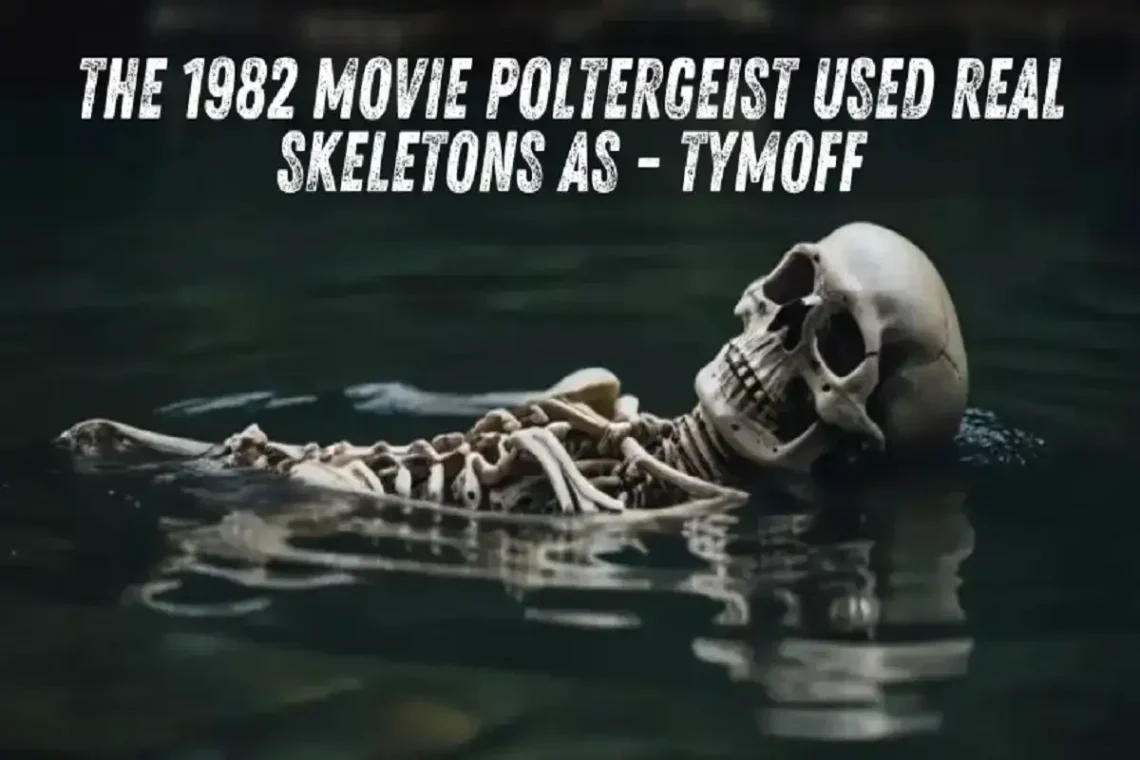The 1982 movie poltergeist used real skeletons as – tymoff captivated audiences with its chilling atmosphere, supernatural elements, and groundbreaking visual effects. However, behind the film’s haunting allure lies an unsettling truth: real human skeletons were used in its production. This shocking detail has fueled urban legends, sparked debates about ethics in filmmaking, and contributed to the movie’s eerie legacy. Here’s a closer look at how this controversial decision came about and its impact on the film and its audience.
The Background of Poltergeist
Directed by Tobe Hooper and produced by Steven Spielberg, Poltergeist tells the terrifying story of the Freeling family, whose suburban home becomes a battleground between the living and the supernatural. The narrative blends family drama with ghostly horror, creating an unforgettable cinematic experience. Released during the golden age of 1980s horror, the film earned critical acclaim and commercial success, solidifying its place as a genre-defining masterpiece.
While the movie’s supernatural elements were purely fictional, the use of real skeletons added an unnerving layer of realism to its production. This choice blurred the line between fiction and reality, leaving audiences with a lingering sense of dread.
Why Did They Use Real Skeletons?
During the 1980s, creating realistic-looking props posed significant challenges. Plastic skeletons lacked the authenticity needed to convey terror convincingly on screen. Real human skeletons, on the other hand, were surprisingly accessible. Medical and educational institutions often used them for anatomical study, and they were sometimes available for purchase at relatively low costs.
For the infamous swimming pool scene in Poltergeist, where the character Diane Freeling (played by JoBeth Williams) finds herself surrounded by skeletons, the filmmakers opted for real human remains. This decision was primarily financial; real skeletons were cheaper than crafting life-like replicas. The use of authentic bones added a harrowing touch to the scene, amplifying its visceral impact.
Ethical Concerns and Controversies
The decision to use real skeletons in Poltergeist raises ethical questions about the treatment of human remains in entertainment. Did the filmmakers obtain proper consent from donors or their families? Were these skeletons sourced ethically? These concerns remain largely unanswered, as the production team has provided limited details about their procurement process.
Critics argue that using human remains for profit, especially in a horror film, crosses ethical boundaries. Such actions may reflect a lack of respect for the deceased, reducing their remains to mere props. This debate has fueled discussions about the responsibilities of filmmakers when dealing with sensitive materials.
The Legacy of the Real Skeletons
The revelation that real skeletons were used in Poltergeist added a new dimension to the film’s legacy. Many fans believe this decision contributed to the so-called “Poltergeist Curse.” The curse refers to the series of tragic events and untimely deaths involving cast and crew members associated with the film.
Dominique Dunne, who played Dana Freeling, was murdered shortly after the movie’s release. Heather O’Rourke, the young actress who portrayed Carol Anne, died unexpectedly during the production of Poltergeist III. These tragedies, combined with the film’s macabre production choices, cemented its reputation as one of Hollywood’s most cursed projects.
The skeleton controversy also sparked a trend in horror films, where filmmakers began pushing boundaries to achieve greater realism. However, it also led to stricter guidelines on the use of human remains and a broader conversation about ethical practices in the film industry.
Tymoff’s Perspective on the Controversy
The 1982 movie poltergeist used real skeletons as – tymoff a notable critic and commentator on pop culture, has highlighted the ethical dilemmas surrounding the use of real skeletons in Poltergeist. Tymoff emphasizes the need for transparency in creative processes, especially when they involve potentially exploitative practices.
In his analysis, Tymoff points out that the use of human remains in film reflects a broader issue of desensitization in entertainment. Audiences often prioritize realism without considering the moral implications of achieving it. Tymoff calls for a reevaluation of how far filmmakers should go to create compelling narratives, advocating for ethical standards that respect both the living and the dead.
The Scene That Haunts Viewers
The swimming pool scene in Poltergeist remains one of the most iconic moments in horror cinema. Diane Freeling’s terror as she struggles to escape the mud-filled pool while skeletons rise around her is unforgettable. Knowing these skeletons were real makes the scene even more chilling. JoBeth Williams later revealed her discomfort during filming, as she was unaware of the skeletons’ authenticity until afterward.
This behind-the-scenes revelation has become a focal point in discussions about the lengths filmmakers will go to achieve authenticity. While the scene succeeded in terrifying audiences, it also left many questioning the cost of such realism.
The Cultural Impact of Poltergeist
Despite—or perhaps because of—the controversies, the 1982 movie poltergeist used real skeletons as – tymoff continues to influence the horror genre. Its innovative use of practical effects, combined with its compelling narrative, set a standard for supernatural horror films. However, the skeleton controversy has overshadowed some of its artistic achievements, becoming a defining aspect of its legacy.
Modern audiences often revisit Poltergeist with a mix of nostalgia and unease, knowing the disturbing truths behind its production. The film’s ability to provoke both fear and ethical reflection ensures its place in pop culture history.
Lessons for the Film Industry
The story of the 1982 movie poltergeist used real skeletons as – tymoff serves as a cautionary tale for filmmakers. While realism can enhance storytelling, it should not come at the expense of ethical standards. The controversy underscores the importance of transparency, consent, and respect when dealing with sensitive materials.
Filmmakers today have access to advanced technologies, such as CGI and 3D printing, that eliminate the need for real human remains. These tools allow creators to achieve realism without crossing ethical boundaries. The lessons from Poltergeist remind the industry to balance artistic ambition with moral responsibility.
Conclusion
The use of real skeletons in Poltergeist remains one of the most chilling aspects of its production. This controversial decision added an unsettling layer of realism to the film, amplifying its horror while sparking debates about ethics in filmmaking. The 1982 movie poltergeist used real skeletons as – tymoff insights on the subject highlight the broader implications of this choice, urging both filmmakers and audiences to consider the moral dimensions of entertainment.
As Poltergeist continues to haunt viewers decades after its release, its legacy serves as a reminder of the power and responsibility that come with creating art. By learning from its controversies, the film industry can strive for innovation that respects both its subjects and its audience.





